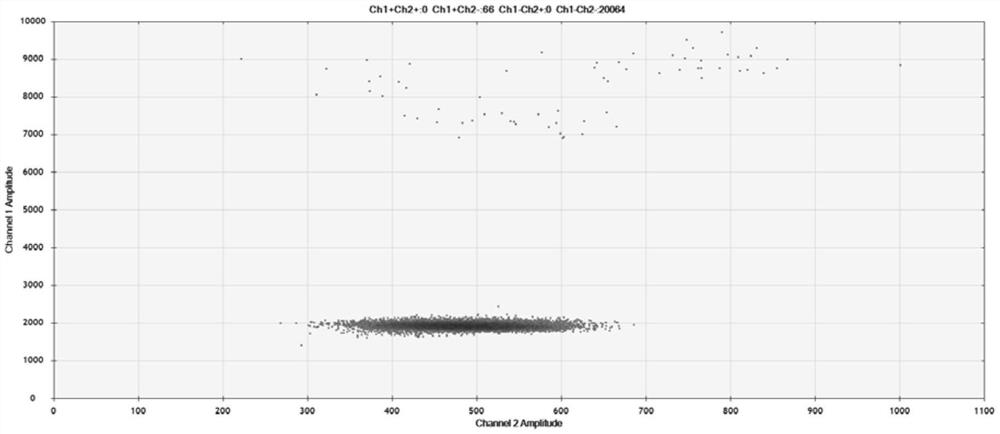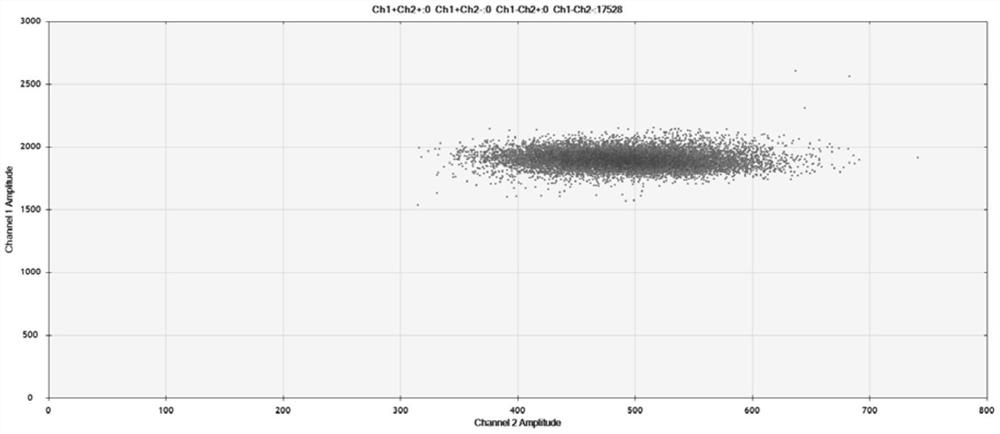Reaction system for detecting EML4-ALK fusion gene based on digital PCR and applications of reaction system
A technology of fusion gene and reaction system, applied in the field of molecular biology detection, can solve problems such as reducing the probability of false positives
- Summary
- Abstract
- Description
- Claims
- Application Information
AI Technical Summary
Problems solved by technology
Method used
Image
Examples
Embodiment 1
[0053] Example 1 Design and establishment of a digital PCR detection system for EML4-ALK gene fusion mutation
[0054] 1. Design of primer-probe combination
[0055] First, according to the subtypes of EML4-ALK gene fusion variants reported in the literature, a variety of subtypes were analyzed, and three main types of fusion variants were selected (accounting for more than 85% of EML4-ALK gene fusion variant subtypes) . Multiple sets of primers and probes were designed across the fusion breakpoint region for specific screening.
[0056] Primer design principles: The primer pair used to detect the fusion variation of the EML4-ALK gene in the present invention is designed by Primer5 and NCBI Blast software; the length of the primers is between 18-25 nucleotides, and the GC content of the primers is between 40%- Between 60%, the Tm value of the primer is ≥60°C. The Tm values of each primer are roughly close to ensure that the primer pair can be amplified efficiently at the ...
Embodiment 2
[0074] Example 2 Detection of tumor tissue samples
[0075] Two cases of tumor tissue samples were selected, and the detection system of the present invention was used to detect their RNA, and the specific operation steps were as follows:
[0076] 1. RNA extraction from tumor tissue samples
[0077] The RNeasy FFPE Kit from QIAGEN was used to extract RNA from 2 tumor tissue samples, and Qubit was used to detect the RNA concentration and quality for later use.
[0078] 2. Perform reverse transcription reaction on RNA to obtain cDNA.
[0079] 2.1 RNA samples were denatured at 72°C for 3 minutes, then cooled in an ice bath;
[0080] 2.2 Reverse transcription reaction: 48°C, 60 minutes; 50°C, 2 minutes, 48°C, 2 minutes, 10 cycles; 70°C enzyme inactivation, 15 minutes; 4°C incubation, the reaction is over.
[0081] 3. PCR amplification
[0082] 3.1 dPCR amplification system preparation
[0083] Prepare the amplification reaction according to the digital PCR reaction system: dP...
Embodiment 3
[0090] Example 3 Detection of plasma free nucleic acid samples
[0091] The plasma samples of 2 patients with lung cancer were selected, and the detection system of the present invention was used to detect their plasma cfRNA, and the specific operation steps were as follows:
[0092] 1. Plasma cfRNA Extraction
[0093] The QIAamp ccfDNA / RNA Kit from QIAGEN was used to extract RNA from 2 plasma samples, and Qubit was used to detect the RNA concentration and quality for later use.
[0094] 2. Perform reverse transcription reaction on RNA to obtain cDNA.
[0095] 2.1 RNA samples were denatured at 72°C for 3 minutes, then cooled in an ice bath;
[0096] 2.2 Reverse transcription reaction: 48°C, 60 minutes; 50°C, 2 minutes, 48°C, 2 minutes, 10 cycles; 70°C enzyme inactivation, 15 minutes; 4°C incubation, the reaction is over.
[0097] 3. PCR amplification
[0098] 3.1 dPCR amplification system preparation
[0099]Prepare the amplification reaction according to the digital PCR ...
PUM
 Login to View More
Login to View More Abstract
Description
Claims
Application Information
 Login to View More
Login to View More - R&D
- Intellectual Property
- Life Sciences
- Materials
- Tech Scout
- Unparalleled Data Quality
- Higher Quality Content
- 60% Fewer Hallucinations
Browse by: Latest US Patents, China's latest patents, Technical Efficacy Thesaurus, Application Domain, Technology Topic, Popular Technical Reports.
© 2025 PatSnap. All rights reserved.Legal|Privacy policy|Modern Slavery Act Transparency Statement|Sitemap|About US| Contact US: help@patsnap.com



